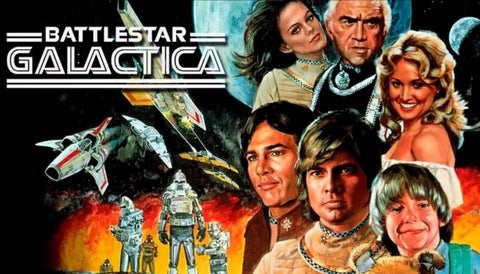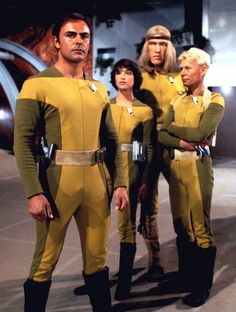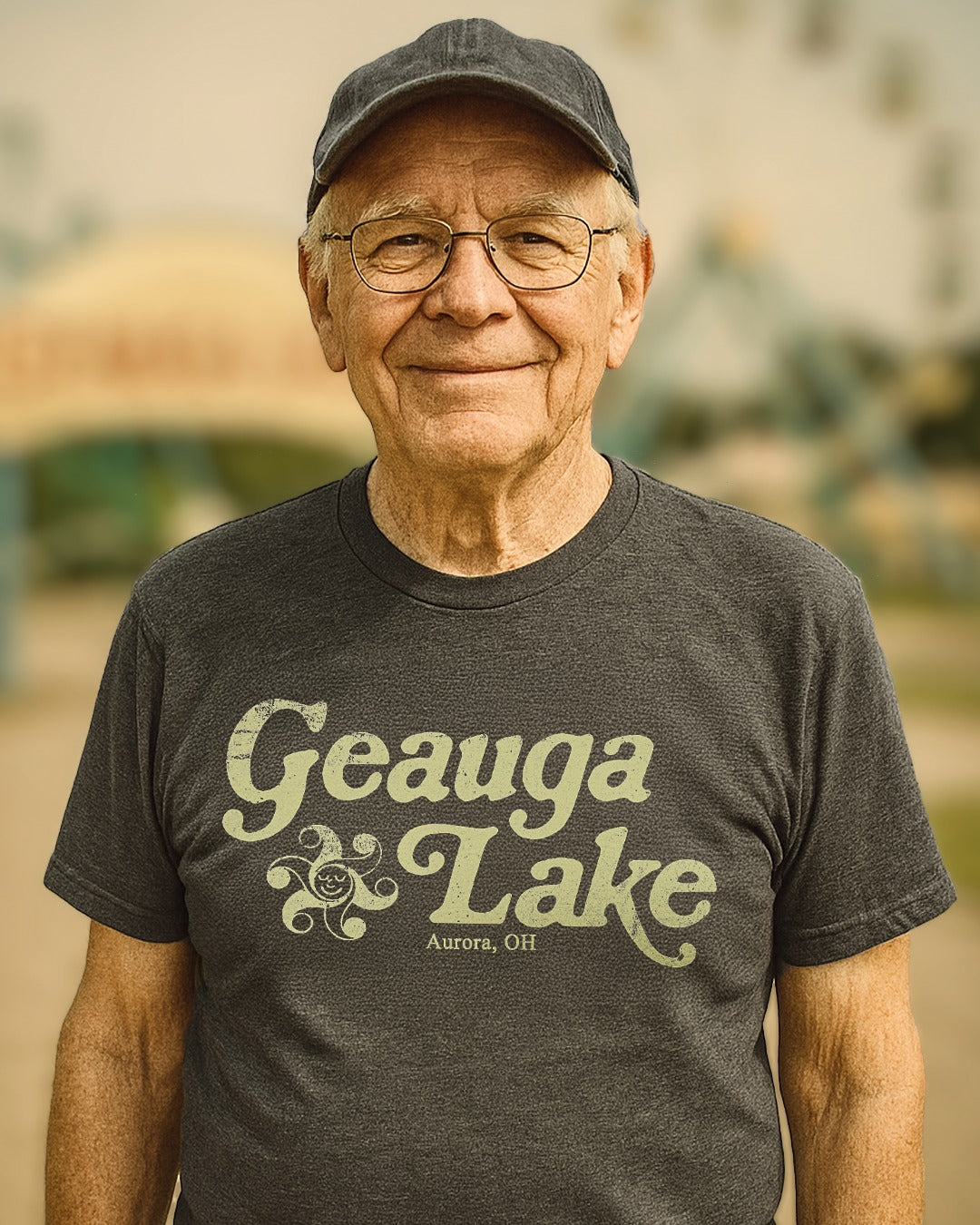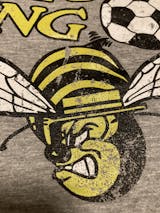Science fiction on TV in the 1970s was a tough sell. While Star Trek: The Original Series was wildly popular in syndication, more so than it ever was in its original network run in the late ‘60s, that level of success eluded other series, including a few produced by Trek’s creator, Gene Rodenberry. Here is a look at the lost science fiction TV shows of the ‘70s.

Use code "lost70s" and take 20% off your entire order of Old School Shirts
UFO (1970)
In the mid-1960s, Gerry Anderson and Sylvia Anderson created the popular, but short-lived, Thunderbirds TV series. Its cast was made up entirely of marionettes. In 1970, the couple created UFO, their first live-action TV effort. The series centered on an alien invasion of Earth and the attempts to thwart such in the year 1980. It ran in syndication in the U.S. in the early ‘70s.
While most of the cast had gotten the single jumpsuit wardrobe sorted, the rest of the show didn’t look ridiculous. Indeed, they still used phones, flew in airplanes (though they were SSTs by that time), and drove automobiles. A total of 26 episodes were produced.

The Starlost (1973)
It has been called the worst science fiction TV show of all time, which is a little unfair. Created by award-winning science fiction writer Harlan Ellison, The Starlost was a joint venture between 20th Century Fox and Canada’s CTV television network.
In 2285, Earth suffered some sort of catastrophe and built a giant space ark divided into several hundred biospheres, unbeknownst to its passengers. The main character, Devon, discovered this and ran off with his girlfriend, who was escaping an arranged marriage.
Great premise. The problem was the special effects were so shoddy it was distracting. It turned out the then state-of-the-art technology the production company was going to use ultimately did not work, which left the creative team scrambling to find workable solutions. Unfortunately, that left The Starlost looking, well, lost.

Star Trek: The Animated Series (1973)
The live-action Star Trek was cancelled in 1969 by NBC. After it saw Star Trek’s popularity in syndication, the network approached the show’s creator, Gene Rodenberry, about continuing the series in animated form. The original cast returned to voice the project, except for Walter Koenig, who played Chekov. He, though, wound up writing a few episodes. The series lasted a season and a half and won an Emmy for Outstanding Entertainment – Children's Series.

Genesis II (1973)/Planet Earth (1974)/Strange New World (1975)
Rodenberry, meanwhile, had not given up on live-action. In 1973 he wrote and produced a TV movie called Genesis II to serve as a pilot for a possible series.
Dylan Hunt, from the 20th century, woke up in a post-apocalyptic world 150 years in the future. Rescued by an organization called PAX, he fought to survive while he also battled the tyrannical beings that controlled the southwestern United States.
The idea was re-worked for Planet Earth in 1974, and again for Strange New World, all of which starred John Saxon as Hunt. None of the three was picked up for series.

The Questor Tapes (1974)
Rodenberry, along with Trek alum Gene L. Coon, produced another TV movie/pilot in 1974. This one centered on an android created by an advanced alien race. Questor, as he was named, was programmed to keep man from destroying himself. The movie starred Robert Foxworth and a pre-M*A*S*H Mike Farrell. Creative differences with the NBC kept it from advancing to series production.

Land of the Lost (1974)
Better known as a Will Farrell comedy movie, this series debuted in 1974 as a Saturday morning kids show produced by Syd and Marty Krofft. The plot focused on the Marshall family (dad Rick along with children Will and Holly), who, after an earthquake, were plunged into an alternate universe populated by dinosaurs and never-before-seen creatures.
While NBC asked the Krofft brothers for “something with dinosaurs,” they, along with showrunner David Gerold (a highly-recognized name in sci-fi), created an impressive little adventure series. Several notable science fiction writers of the time, including many who wrote for Star Trek, contributed scripts to the show. Across its three seasons, 43 episodes were produced.

Planet of the Apes (1974)
In 1973, the fifth film in the Planet of the Apes film franchise was released and achieved solid box office returns. That, combined with the ratings success of previous installments on broadcast TV, prompted 20th Century Fox to develop a TV show.
Roddy McDowell, who played the ape Cornelius in the original films, came on board to play Galen. He helped astronauts Alan Virdon and Peter Burke who had been stranded in an ape-controlled future, following the premise of the original film. Mark Lenard, who was familiar to Star Trek fans as Spock’s father, Sarek, played the gorilla Urko who tried to capture the two humans.
The show only aired 14 episodes before being canceled in December of 1974
 .
.
Space: 1999 (1975)
UFO creators Gerry Anderson and Sylvia Anderson were approached by ITC, the company that produced that program, and tasked with coming up with a second season of the show. At that time, it was having a successful run in syndication in the U.S., and ITC saw a chance to keep the money flowing on both sides of the Atlantic.
As the episodes based on the moonbase were the most popular ones in the series, the Andersons decided UFO 2 would take place on the moon. However, by the time the project was ready, interest in the show had waned in the U.S. The couple then re-worked the idea into Space:1999.
In the pilot movie, a nuclear explosion knocked the moon out of orbit, sending the Earth’s lone satellite hurtling through space. The ridiculous premise aside, the show was well-written and had impressive special effects. To improve the series, Fred Freiberger, who had produced Star Trek’s third and final season was brought in.
However, he never meshed with the cast. A change in direction that was intended to improve the show instead drove viewers away. It was canceled after its second season.

Far Out Space Nuts (1975)
Also produced by Sid & Marty Krofft, this sci-fi comedy series aired on Saturday mornings on CBS. It starred Bob Denver of Gilligan's Island fame and Chuck McCann. The two, after loading food into a rocket, are accidentally launched into space. Each episode found them running into or, being captured by, all manner of alien life. The series lasted 15 episodes.

ARK II (1976)
Another live-action Saturday morning science fiction series, ARK II was produced by Filmation, the same company that did the animated Star Trek. It was the first of several Saturday morning science fiction shows that Filmation created.
In the year 2476, in a post-apocalyptic world, a small team of scientists roamed the Earth in a high-tech vehicle searching for, and helping, the surviving groups of humans they found. Fifteen episodes were produced. When the show was in production, scenes with the futuristic vehicle had to be shot in the morning as it would usually break down by lunchtime and take the rest of the day to fix.

Logan’s Run (1977)
The hit 1976 film Logan’s Run was the inspiration for this short-lived TV series. Following the same premise as the movie, Logan 5 escaped the underground City of Domes after turning 30. It was at that age that the city’s citizens were “re-newed,” which Logan discovers was not a form of reincarnation but extermination to control the population. Along with his girlfriend Jessica 6, he was pursued by his former friend and co-worker Francis 7.
Unfortunately, some silly additions, like the android Rem, and special effects that were underwhelming even for the time, kept audiences away, and the series was canceled after just 14 episodes.

Space Academy (1977)/Jason of Star Command (1978)
A year after ARK II left the air, Filmation brought out Space Academy. It took place in the year 3732, and as the title suggested, was a training school for brilliant young minds. It also aired on Saturday mornings.
Jonathan Harris, of the 1960s science fiction series Lost in Space, starred as the head of the academy. One of the small spacecraft used by the academy, called a Seeker, was the repurposed vehicle from ARK II.
In 1978, a spin-off called Jason of Star Command debuted. Star Command was said to be a special section of the Space Academy. The series starred James “Scotty” Doohan of Star Trek fame, along with Craig Little in the title role. The Academy closed in 1979. Jason last flew in 1981.
Quark (1977)
Richard Benjamín starred in this sci-fi sit-com created by Buck Henry (Get Smart). The series followed the adventures of a United Galaxy Sanitation Patrol cruiser captained by Adam Quark (Benjamin). The show parodied several contemporary science fiction movies and TV shows including, Star Trek, Star Wars, and 2001: A Space Odyssey, as well as older staples such as Flash Gordan. The series lasted only eight episodes.

Blake’s 7 (1978)
Produced by BBC 1, Blake’s 7 was a hit right from the start and lasted four seasons. It was shown on PBS in the United States and developed a cult following.
The action took place 700 years in the future and centered on Roj Blake, who commanded a group of rebels battling a totalitarian government. After he was tried and convicted on bogus charges, he escaped, along with a few other prisoners, and took over the spacecraft that was transporting them to a penal colony. Blake and his crew were pursued throughout the series by the government’s Travis and Servalan.

Battlestar Galactica (1978)
Though it came out in the wake of Star Wars, the idea for this series was conceived in the late 1960s, according to its creator Glenn Larson. It wasn’t until the success of Star Wars that he was able to get the green light from Universal Studios for his project, which was originally titled Adam’s Ark.
Indeed, so keen was Universal on the concept after seeing the success of Star Wars, it scheduled the project to be a theatrical release. The name was changed to Saga of a Starworld, but before it could be released, 20th Century Fox, the studio behind Star Wars, sued citing copyright infringement. Universal countersued.
As the lawsuit dragged on, the project was renamed again and developed into a TV series, at a then-record $1 million per episode, for ABC called Battlestar Galactica and used the original film as the pilot episode.
The saga started with a group of humans from 12 different planets , or colonies, all in the same solar system, headed to sign a peace agreement with the robotic Cylons with whom they had been at war for centuries. The Cylons, however, attacked the humans and destroyed all but one Battlestar, the Galactica. The surviving ship then led a fleet of small craft on a search for Earth (the missing 13th colony) with the Cylons in hot pursuit. The chase only lasted one season, though.
In 1979, a spin-off called Galactic 1980 premiered. In this budget-friendly series, the Galactica found Earth and then set about trying to prevent a Cylon invasion. It only lasted 10 episodes. On some streaming platforms, this presented as a second season of Battlestar Galactica. In 2004, the original series was re-imagined, to critical acclaim.

Buck Rogers in the 25th Century (1979)
Also produced by Glen Larson, this show was based on the Buck Rogers character created in 1928 and that had previously appeared in several films, comic books, and TV shows.
The modern version starred Gil Gerard as Buck, a NASA astronaut. After his spacecraft launched in 1987, it malfunctioned, and he was frozen in space for 500 years. After being revived, he got a place in New Chicago and signed on with the Earth Defense Directorate which was tasked with protecting (you may have guessed) a post-apocalyptic Earth.
The show used many sets and other production elements from its sibling show Battlestar Galactica and lasted two seasons before being canceled.

Salvage 1 (1979)
Between gigs playing a rural sheriff and a big city lawyer, Andy Griffith starred in this fanciful science fiction series. He played Henry Broderick, owner of a salvage company, who builds a spacecraft in order to retrieve the equipment left on the Moon by NASA after the Apollo landings. The pilot debuted to high ratings. The subsequent series produced 20 episodes across two seasons, but was cancelled with four unaired.




